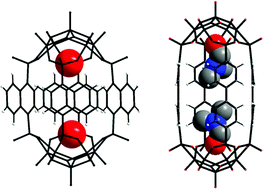Self-assembly of hybrid organic–inorganic polyoxovanadates: functionalised mixed-valent clusters and molecular cages†
Abstract
Herein we report the intra- and inter-molecular

Maintenance work is planned for Wednesday 1st May 2024 from 9:00am to 11:00am (BST).
During this time, the performance of our website may be affected - searches may run slowly and some pages may be temporarily unavailable. If this happens, please try refreshing your web browser or try waiting two to three minutes before trying again.
We apologise for any inconvenience this might cause and thank you for your patience.
* Corresponding authors
a
School of Chemistry & CRANN, University of Dublin, Trinity College, Dublin 2, Ireland
E-mail:
schmittw@tcd.ie
Fax: +353 1 671 2826
Tel: +353 1 896 3495
b CNRS, CRPP, UPR 8641, Centre de Recherche Paul Pascal, Equipe “Matériaux Moléculaires Magnétiques”, 115 avenue du Dr. Albert Schweitzer, F-33600 Pessac, France
c Univ. Bordeaux, CRPP, UPR 8641, F-33600 Pessac, France
d School of Biochemistry and Immunology, University of Dublin, Trinity College, Dublin 2, Ireland
Herein we report the intra- and inter-molecular

 Please wait while we load your content...
Something went wrong. Try again?
Please wait while we load your content...
Something went wrong. Try again?
J. M. Breen, R. Clérac, L. Zhang, S. M. Cloonan, E. Kennedy, M. Feeney, T. McCabe, D. C. Williams and W. Schmitt, Dalton Trans., 2012, 41, 2918 DOI: 10.1039/C2DT11153E
To request permission to reproduce material from this article, please go to the Copyright Clearance Center request page.
If you are an author contributing to an RSC publication, you do not need to request permission provided correct acknowledgement is given.
If you are the author of this article, you do not need to request permission to reproduce figures and diagrams provided correct acknowledgement is given. If you want to reproduce the whole article in a third-party publication (excluding your thesis/dissertation for which permission is not required) please go to the Copyright Clearance Center request page.
Read more about how to correctly acknowledge RSC content.
 Fetching data from CrossRef.
Fetching data from CrossRef.
This may take some time to load.
Loading related content
